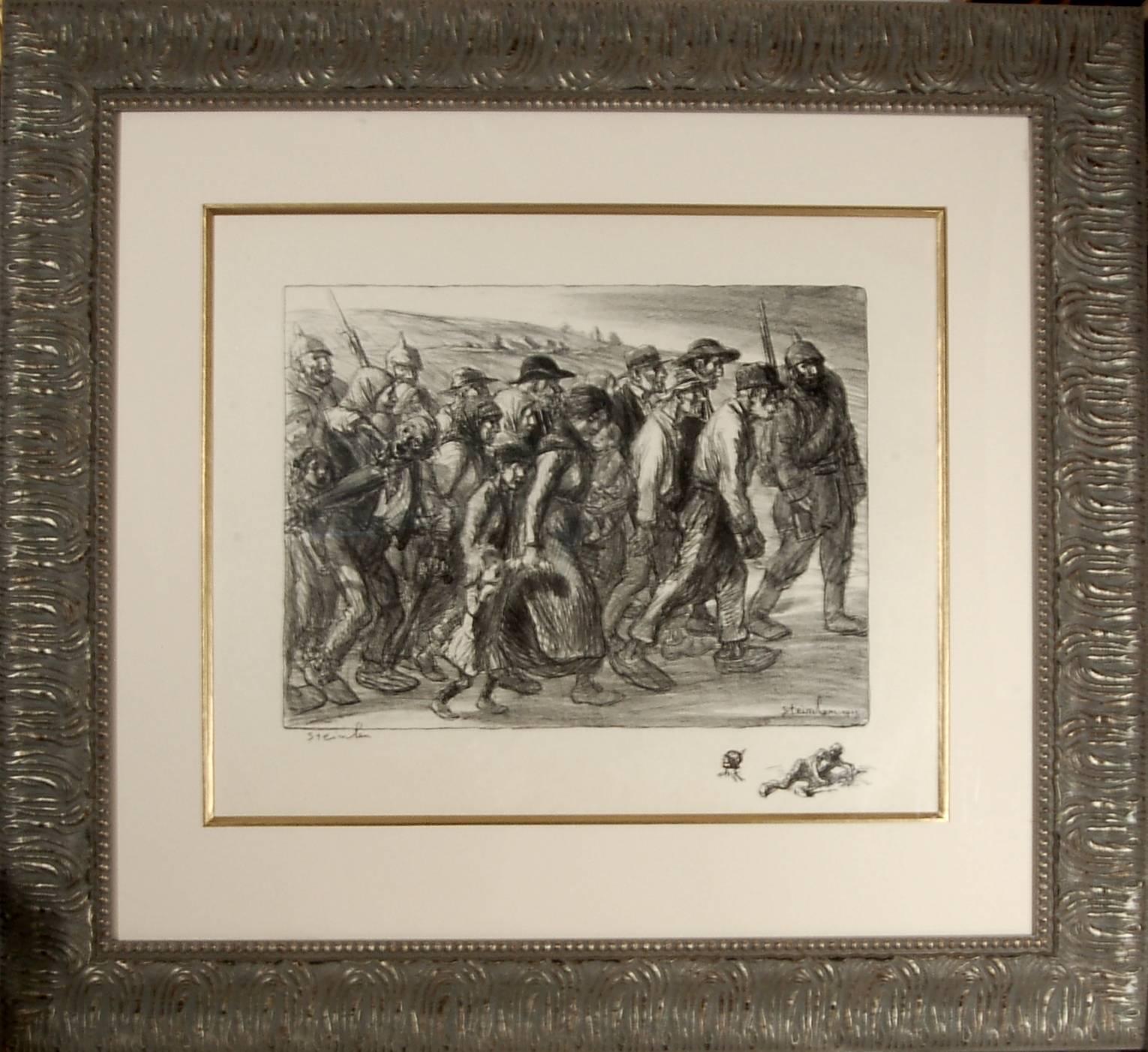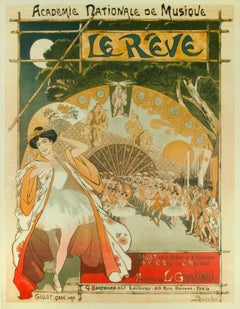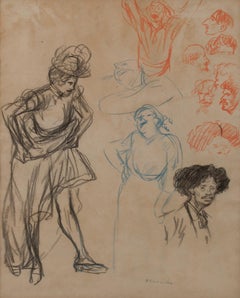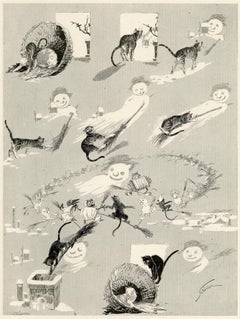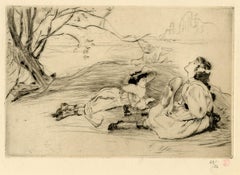Items Similar to “La Rèpublique nous appelle…” (The Republic calls us…)
Want more images or videos?
Request additional images or videos from the seller
1 of 11
Théophile Alexandre Steinlen“La Rèpublique nous appelle…” (The Republic calls us…)1915
1915
$600
£456.75
€522.16
CA$844.21
A$923.42
CHF 486.21
MX$11,024.75
NOK 6,196.79
SEK 5,668.59
DKK 3,900.02
About the Item
La République Nous Appelle (The Republic Calls Us)
Transfer lithograph with an etching Remarque in the lower left corner, 1915
Signed in pencil lower right (see photo)
Edition: 100 (1/100) (see photo)
An impression from the deluxe edition of 100 numbered impressions, this being 1/100, signed in pencil by the artist. From the collection of the publisher, Edmund Sagot, Paris
Provenance:
Edmund Sagot (1857-1917), noted publisher and dealer
By descent
Reference: Not in Crauzat which was published in 1913
Note: The title refers to verses from the anthem of the Revolution of 1794, Chant du depart written by Méhul and Chénier.
Théophile Alexandre Steinlen
(1859-1923)
Théophile-Alexandre Steinlen was born in 1859 Lausanne, where he studied literature at the academy. Later he did an internship with a textile printer in Mulhouse. In 1878 Théophile-Alexandre Steinlen went to Paris, where he initially earned a living as a technical draftsman. In 1883 Théophile-Alexandre Steinlen moved to the artists' neighborhood of Montmartre, where he met and made friends with artists like Toulouse-Lautrec, Aristide Bruant, Vallaton and Alphone Allais. At that time, Théophile-Alexandre Steinlen worked as a draftsman and illustrator for the papers 'Le Chat Noir' and 'Le Mirliton'. In 1884 he held his first exhibition at La Bodinière. In 1885 Théophile-Alexandre Steinlen drew the first of his famous posters: a poster for the Hotel de Paris in Trouville sur Mer. Posters for La Compagnie Francaise, the Cabarét Le Chat Noir and many others followed. In 1911 Théophile-Alexandre Steinlen founded the paper 'Les Humorists' together with Forain and Léandre and worked as a book illustrator. From 1893 he exhibited his works at the Salon des Indépendants and later regularly held exhibitions at the Salon des Humoristes. Politically opposed to the war, Théophile-Alexandre Steinlen drew numerous posters against World War I. Théophile-Alexandre Steinlen died in Paris in 1923.
Courtesy: Theophile-Alexandre-Steinlen
- Creator:Théophile Alexandre Steinlen (1859 - 1923, French)
- Creation Year:1915
- Dimensions:Height: 24 in (60.96 cm)Width: 27.25 in (69.22 cm)
- Medium:
- Period:
- Condition:Printed on a heavy Arches laid paper. Slight foxing to sheet.
- Gallery Location:Fairlawn, OH
- Reference Number:Seller: FA91041stDibs: LU14015880682
Théophile Alexandre Steinlen
Theophile Alexandre Steinlen was born in Lausanne in 1859. He was naturalized French in 1901. He was a painter, engraver, illustrator, poster artist and sculptor. Before settling in Paris, he made a detour to Mulhouse where one of his uncles placed him in the studio of one of the best lithographers of the time. He settled definitively in Montmartre in 1881. Willette introduced him to his companions of the Cabaret du Chat-Noir animated by Rodolphe Salis. He met Toulouse-Lautrec, Forain, Léandre, Debussy, Eric Satie, Verlaine, Alphonse Allais and Aristide Bruant. He took part in the performances of the famous cabaret's shadow theater with animal stories and, most often, sequences featuring cats, for which he has a particular affection. The felines will appear throughout his activity as "parentheses" in a tormented work. There is, in this torment, the expression of no personal problem but a painful compassion for the lives of the exploited and marginal beings. He painted and drew idylls, balls and bastrings, workers, kids and gosselin, the poor, the little workers, girls and marlous. He sometimes made posters. In the most successful of them (« Le lait pur de la Vingeanne » et le « Fer Bravais ») he imposed, relevant or not, the presence of cats.
In 1901, Steinlen worked for L'Assiette au beurre , the most virulent satirical newspaper ever published and takes readily to target the institutions of the 3rd Republic.
His works are found in numerous Public Collections, such as Petit Palais in Geneva, Hermitage Museum in Saint Petersburg, and the National Gallery of Art in Washington.
About the Seller
5.0
Recognized Seller
These prestigious sellers are industry leaders and represent the highest echelon for item quality and design.
Gold Seller
Premium sellers maintaining a 4.3+ rating and 24-hour response times
Established in 1978
1stDibs seller since 2013
835 sales on 1stDibs
Typical response time: <1 hour
Associations
International Fine Print Dealers Association
- ShippingRetrieving quote...Shipping from: Fairlawn, OH
- Return Policy
More From This Seller
View AllLe Rêve (The Dream)
By Théophile Alexandre Steinlen
Located in Fairlawn, OH
Le Rêve (The Dream)
Color gillotage poster, 1890
Signed in the image lower right corner (see photo)
This poster for a ballet at the Académie nationale de musique in Paris is typical ...
Category
1890s Impressionist Figurative Prints
Materials
Lithograph
Double sided crayon drawing in colors: Study for "The Shoe" (recto)
By Théophile Alexandre Steinlen
Located in Fairlawn, OH
Double sided crayon drawing:
Front: Study for "The Shoe"
Reverse: Studies of Figures
Blue crayon, red and black crayons
Image size: 19.25 x 15.375 inches
Frame size: 30 x 25 1/2 inch...
Category
1890s Art Nouveau Figurative Drawings and Watercolors
Materials
Crayon
"Kitten Went in the Night" (A black cat playing with broom and Halloween ghost)
By Théophile Alexandre Steinlen
Located in Fairlawn, OH
"Kitten Went in the Night" (A black cat playing with broom and Halloween ghost) from Le Chat Noir
Gillotage chromotype, 1898
Signed in the image lower right
Cats were a symbol of fr...
Category
1890s Impressionist Animal Prints
Materials
Other Medium
A L'Ombre (In Shadow)
By Louis Legrand
Located in Fairlawn, OH
A L'Ombre (In Shadow)
Etching & drypoint, 1905
Signed with the red stamp of the publisher Pellet (see photo)
Edition: 50 on velin paper, signed and numbered
Publisher: Gustav Pellet, Paris (his red stamp lower right, recto; Lugt 1193)
Condition: Excellent
Image/Plate size: 5-7/8 x 8-5/8" (14.8 x 21.8 cm.)
Sheet size: 11 5/8 x 17 1/8"
Reference: IFF 119
Exteens 229
Arwas 256 v/V
Louis Auguste Mathieu Legrand (29 September 1863 – 1951) was a French artist, known especially for his aquatint engravings, which were sometimes erotic. He was awarded the Légion d'honneur for his work in 1906.
Life
Legrand was born in the city of Dijon in the east of France. He worked as a bank clerk before deciding to study art part-time at Dijon's Ecole des Beaux-Arts. He won the Devosge prize at the school in 1883.[2] In 1884 Legrand studied engraving under the Belgian printmaker Félicien Rops.
Legrand's artworks include etchings, graphic art and paintings. His paintings featured Parisian social life. Many were of prostitutes, dancers and bar scenes, which featured a sense of eroticism. According to the Hope Gallery, "Louis Legrand is simply one of France's finest early twentieth century masters of etching." His black and white etchings especially provide a sense of decadence; they have been compared to those of Henri de Toulouse-Lautrec, though his drawings of the Moulin Rouge, the can-can dance and the young women of Montmartre preceded Toulouse-Lautrec's paintings of similar scenes. He made over three hundred prints of the night life of Paris. They demonstrate "his remarkable powers of observation and are executed with great skill, delicacy, and an ironic sense of humor that pervades them all."
Two of his satirical artworks caused him to be tried for obscenity. The first, "Prostitution" was a symbolic drawing which depicted a naked girl being grasped by a dark monster which had the face of an old woman and claws on its hands; the second, "Naturalism", showed the French novelist Émile Zola minutely studying the thighs of a woman with a magnifying glass. Defended by his friend the lawyer Eugène Rodrigues-Henriques (1853–1928), he was found not guilty in the lower court, but was convicted in the appeal court and then given a short prison sentence for refusing to pay his fine.
Legrand was made famous by his colour illustrations for Gil Blas magazine's coverage of the can-can, with text by Rodrigues (who wrote under the pseudonym Erastene Ramiro). It was a tremendous success, with the exceptional quantity of 60,000 copies of the magazine being printed and instantly sold out in 1891.
In 1892, at the instigation of the publishing house Dentu, Legrand made a set of etchings of his Gil Blas illustrations. The etchings were published in a book, Le Cours de Danse Fin de Siecle (The End of the Century Dance Classes).
Legrand took a holiday in Brittany, which inspired him to engrave a set of fourteen lithographs of simple country life called Au Cap de la Chevre (On Goat Promontory). It was published by Gustave Pellet who became a close friend of Legrand's. Pellet eventually published a total of 300 etchings by Legrand, who was his first artist; he also published Toulouse-Lautrec and Félicien Rops among others.
He did not only work in graphics; he exhibited paintings at the Paris salon of the Société Nationale des Beaux-Arts starting in 1902. In 1906 he was made a chevalier of the Légion d'honneur.
Legrand died in obscurity in 1951. A retrospective exhibition was held at the Félicien Rops museum in Namur, Belgium in 2006 to celebrate his graphic art. The art collector Victor Arwas published a catalogue raisonné for the occasion.
Books illustrated
de Maupassant, Guy: Cinq Contes Parisiens, 1905.
Poe, Edgar Alan: Quinze Histoires d'Edgar Poe...
Category
Early 1900s Art Nouveau Landscape Prints
Materials
Etching
A black and white cat play with a mouse, from Le Chat Noir
By Théophile Alexandre Steinlen
Located in Fairlawn, OH
A black and white cat play with a mouse, from Le Chat Noir
Gillotage chromotype, 1898
Signed in the image lower right (see photo)
An impression of this image is in the collection of ...
Category
1890s Impressionist Animal Prints
Materials
Other Medium
La Toilette
By Louis Legrand
Located in Fairlawn, OH
La Toilette
Drypoint, 1908
Signed and numbered in pencil by the artist (see photos)
Edition: 65 this state (35/65)
Published by Gustave Pellet (1859-1919),...
Category
Early 1900s Art Nouveau Figurative Prints
Materials
Drypoint
You May Also Like
Retour de Guerre
By Théophile Alexandre Steinlen
Located in San Francisco, CA
Artist: Theophile Alexandre Steinlen (Swiss, 1859-1923)
Title: Retour de Guerre
Year: 1915
Medium: Lithograph
Edition: Numbered 97/100 in pencil
Paper: Wove
Image size: 11.5 ...
Category
Early 20th Century Realist Figurative Prints
Materials
Lithograph
Untitled
By Théophile Alexandre Steinlen
Located in San Francisco, CA
Artist: Theophile Alexandre Steinlen (Swiss, 1859-1923)
Title: Untitled
Year: c.1915
Medium: Lithograph
Edition: Unknown, probably 400
Paper: Thin vellum
Image size: 1...
Category
Early 20th Century Realist Figurative Prints
Materials
Lithograph
A Bientot Pour de Bon
By Théophile Alexandre Steinlen
Located in San Francisco, CA
Artist: Theophile Alexandre Steinlen (Swiss, 1859-1923)
Title: A Bientot Pour de Bon
Year: 1916
Medium: Lithograph
Edition: Numbered 99/100 in pencil
Pa...
Category
Early 20th Century Realist Figurative Prints
Materials
Lithograph
Evacues
By Théophile Alexandre Steinlen
Located in San Francisco, CA
Artist: Theophile Alexandre Steinlen (Swiss, 1859-1923)
Title: Evacues
Year: 1916
Medium: Lithograph
Edition: Numbered 98/100 in pencil
Paper: Japan
Image size: 14 x 9.5 inch...
Category
Early 20th Century Realist Figurative Prints
Materials
Lithograph
Les Voila
By Théophile Alexandre Steinlen
Located in San Francisco, CA
Artist: Theophile Alexandre Steinlen (Swiss, 1859-1923)
Title: Les Voila
Year: 1915
Medium: Original lithograph
Edition: Numbered 73/100 in pencil
Paper: Wove
Size image: 16 ...
Category
Early 19th Century Academic Figurative Prints
Materials
Lithograph
Les Otages Civils
By Théophile Alexandre Steinlen
Located in San Francisco, CA
This artwork titled, Les Otages Civils, 1916 is an original lithograph on Japan paper by Swiss/French artist Theophile Alexandre Steinlen, 1859-1923. It is signed and numbered out of...
Category
1910s Impressionist Figurative Prints
Materials
Lithograph
More Ways To Browse
Hotel De Paris
Hotel Posters
Renoir Hand Signed
Roger Jourdain
Rouault Passion
Roy Lichtenstein Composition
Roz Chast
Sally Michael
Salvador Dali Cerberus
Salvador Dali Ea
Salvador Dali Heart
Salvador Dali Moses
Sandu Liberman Lithograph
Scott Jacobs
Shepard Fairey Lithograph
Shepard Fairey War
Signed Mucha Lithograph
Skate Decks Keith Haring
